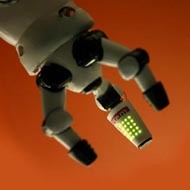New sensors give robots a touch of humanity
A touch sensor developed to match the sensitivity of the human finger is set to herald the age of the robotic doctor.

Until now robots have been severely handicapped by their inability to feel objects with anything like the accuracy of their human creators. The very best are unable to beat the dexterity of the average six-year-old at tying a shoelace or building a house of cards.
But all that could change with the development by nanotechnologists of a device that can "feel" the shape of a coin down to the detail of the letters stamped on it, reports Times Online.
According to Scientific American, the novel technology, described in today's issue of Science, also offers an advantage over earlier ones because it is self-assembled. The thin film consists of layers of gold and semiconducting nanoparticles that are produced out of solution, so the sensor can be built to conform to complex shapes, such as those on robotic appendages or surgical instruments. "You ultimately have to make a device on a very curved surface, like a cylinder, or an endoscope. Most of the existing technologies are too rigid; they won't bend that far," Saraf says.
The next step for this technology, according to Saraf, is to try to use its sensitivity to discern cancer cells from normal cells during surgery. By "feeling" tissue with the sensor, a surgeon may one day be able to differentiate and remove only diseased cells, leaving healthy tissue intact. In the future, it may also be possible to use similar technology to detect temperature as well as pressure, leading to improvements in the resolution of infrared cameras and ultrasound scans.
As a demonstration experiment for the Science paper, Saraf and Maheshwari pressed a penny against a sample device and, using a charged-couple device camera, they were able to decipher fine features such as wrinkles in Abraham Lincoln's clothing.
Saraf said the device also has potential uses in robotics.
"Touch is a sensation they want in robotics because to tell the difference between a cube and a sphere, an ordinary robot takes forever to do it with vision because it has to look from all directions," he said. "With touch, it would 'feel' the sharp edges and say, 'Oh, this is a cube.' And then, of course, the big thing for the military is to maneuver in darkness. Similar to a blind person, (with this device) you can touch and find your way through."
But what interests him most, he said, is the device's potential in the fight against cancer.
"I am excited about this because I want to try to decipher cancer at the single-cell level," Saraf said. "Because in some cases, cancer tissues are harder than normal tissues, if you take a tissue sample, put it on a glass slide and press on it, you would be able to see a cluster of just a few (cancer) cells with this method because it can sense down to about 10 microns (10 millionths of a meter). Surgeons will be able to know if they have taken out all of the cancer. If they haven't, they'll know where to make the next cut," informs Technology News Daily.
O.Ch.Subscribe to Pravda.Ru Telegram channel, Facebook, RSS!





